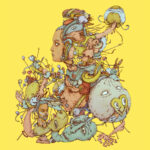La vida breve (Spanish Life is Short or The Brief Life) is an opera in two acts and four scenes by Manuel de Falla to an original Spanish libretto by Carlos Fernández-Shaw. Local (Andalusian) dialect is used. It was written between August 1904 and March 1905, but not produced until 1913. The first performance was given (in a French translation by Paul Millet) at the Casino Municipal in Nice on 1 April 1913. Paris and Madrid performances followed, later in 1913 and in 1914 respectively. Claude Debussy played a major role in influencing Falla to transform it from the number opera it was at its Nice premiere to an opera with a more continuous musical texture and more mature orchestration. This revision was first heard at the Paris premiere at the Opéra-Comique in December 1913, and is the standard version.
Only an hour long, the complete opera is seldom performed today, but its orchestral sections are, especially the act 2 music published as Interlude and Dance, which is popular at concerts of Spanish music. (Fritz Kreisler in 1926 arranged for violin and piano the dance from this pairing under the spurious title Danse espagnole.) Indeed the opera is unusual for having nearly as much instrumental music as vocal: act 1, scene 2 consists entirely of a short symphonic poem (with distant voices) called Intermedio, depicting sunset in Granada; act 2, Scene 1 includes the above-referenced Danza and Interludio, with the latter ending the scene, i.e. in the opposite sequence to the excerpted pairing; and act 2, scene 2 begins with a second and longer Danza (with vocal punctuation).
– From Wikipedia


 It began with a childhood dream growing up in Nova Scotia. At the age of 18 months, Kevin’s first teacher was his mom.
It began with a childhood dream growing up in Nova Scotia. At the age of 18 months, Kevin’s first teacher was his mom. Armand Birk
Armand Birk
 By the 9th century christianity had spread amonst Celtic lands and blended with older Celtic rights. Christians celebrated All Souls’ Day, potentially in an attempt to replace Samhain and other non christian celebrations with a church approved holiday. The All Saints day was also known as All-Hallows or All-hallowmans, and the night before as All-Hallows Eve, which ultimately became Halloween.
By the 9th century christianity had spread amonst Celtic lands and blended with older Celtic rights. Christians celebrated All Souls’ Day, potentially in an attempt to replace Samhain and other non christian celebrations with a church approved holiday. The All Saints day was also known as All-Hallows or All-hallowmans, and the night before as All-Hallows Eve, which ultimately became Halloween.